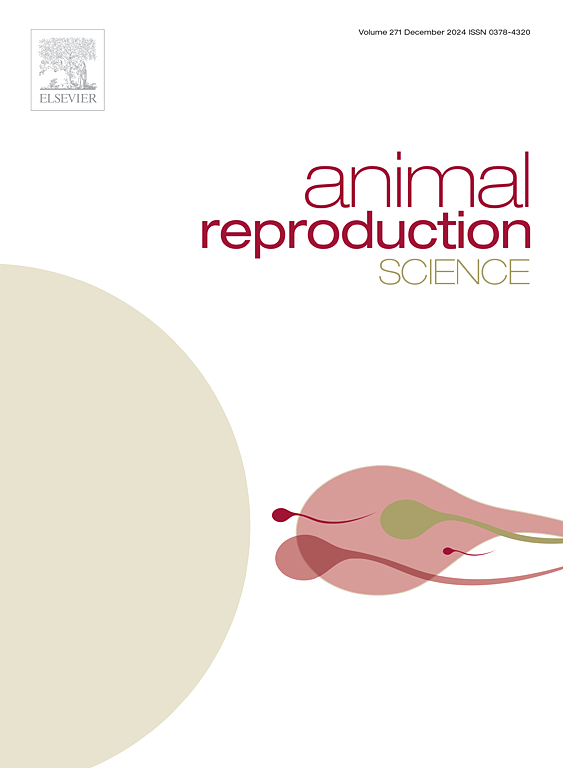Antioxidant components of ram seminal plasma are influenced by age, season, and the RsaI polymorphism of the MTNR1A gene
IF 2.2
2区 农林科学
Q1 AGRICULTURE, DAIRY & ANIMAL SCIENCE
引用次数: 0
Abstract
Melatonin regulates reproductive seasonality in sheep, and its concentration in the blood plasma is influenced by day length and age. It can act directly or by modulating antioxidant defense enzymes. The RsaI polymorphism (g.17355458 C > T) of the melatonin receptor MT1 gene (MTNR1A) has been associated with changes in ram semen and reproductive behavior. But it remains unknown how age and this polymorphism affect melatonin concentration and the activities of antioxidant defense enzymes in ram seminal plasma. The aim of this study was therefore to analyze the effect of the RsaI polymorphism on melatonin levels and the activities of catalase (CAT), glutathione reductase (GRD), and glutathione peroxidase (GPx) in the seminal plasma of young and adult rams carrying different MTNR1A genotypes. For this purpose, seminal plasma was obtained from 15 young (16-month-old) and 9 adult (5-year-old) genotyped rams, and melatonin levels and CAT, GRD, and GPx activities were assessed for a year. Adult rams had higher melatonin concentrations in their seminal plasma than young rams. Adult CC and CT rams had the highest melatonin levels during the reproductive season, whereas young rams showed no differences between seasons. Adult rams also showed higher levels of GRD and GPx activity during the reproductive season; however, young rams showed higher levels of GPx activity during the non-reproductive season than during the reproductive season. These findings highlight the importance of considering the animal age when analyzing ram seminal plasma and its components.
公羊精浆中抗氧化成分受年龄、季节和MTNR1A基因RsaI多态性的影响
褪黑素调节绵羊的繁殖季节性,其在血浆中的浓度受日长和年龄的影响。它可以直接或通过调节抗氧化防御酶起作用。RsaI多态性(g.17355458 C >;褪黑激素受体MT1基因(MTNR1A)的T)与公羊精液和生殖行为的变化有关。但年龄和这种多态性如何影响公羊精浆中褪黑素浓度和抗氧化防御酶的活性尚不清楚。因此,本研究旨在分析RsaI多态性对携带不同MTNR1A基因型的公羊幼羊和成年公羊精浆中褪黑素水平以及过氧化氢酶(CAT)、谷胱甘肽还原酶(GRD)和谷胱甘肽过氧化物酶(GPx)活性的影响。为此,研究人员采集了15只16个月大的公羊和9只5岁大的公羊的精浆,并对褪黑素水平以及CAT、GRD和GPx活性进行了为期一年的评估。成年公羊的精浆中褪黑素浓度高于幼年公羊。成年CC和CT公羊在繁殖季节褪黑素水平最高,而年轻公羊在季节之间没有差异。成年公羊在繁殖季节也表现出较高的GRD和GPx活性;而非繁殖季节的公羊GPx活性高于繁殖季节。这些发现强调了在分析公羊精浆及其成分时考虑动物年龄的重要性。
本文章由计算机程序翻译,如有差异,请以英文原文为准。
求助全文
约1分钟内获得全文
求助全文
来源期刊

Animal Reproduction Science
农林科学-奶制品与动物科学
CiteScore
4.50
自引率
9.10%
发文量
136
审稿时长
54 days
期刊介绍:
Animal Reproduction Science publishes results from studies relating to reproduction and fertility in animals. This includes both fundamental research and applied studies, including management practices that increase our understanding of the biology and manipulation of reproduction. Manuscripts should go into depth in the mechanisms involved in the research reported, rather than a give a mere description of findings. The focus is on animals that are useful to humans including food- and fibre-producing; companion/recreational; captive; and endangered species including zoo animals, but excluding laboratory animals unless the results of the study provide new information that impacts the basic understanding of the biology or manipulation of reproduction.
The journal''s scope includes the study of reproductive physiology and endocrinology, reproductive cycles, natural and artificial control of reproduction, preservation and use of gametes and embryos, pregnancy and parturition, infertility and sterility, diagnostic and therapeutic techniques.
The Editorial Board of Animal Reproduction Science has decided not to publish papers in which there is an exclusive examination of the in vitro development of oocytes and embryos; however, there will be consideration of papers that include in vitro studies where the source of the oocytes and/or development of the embryos beyond the blastocyst stage is part of the experimental design.
 求助内容:
求助内容: 应助结果提醒方式:
应助结果提醒方式:


